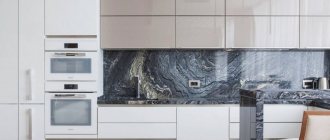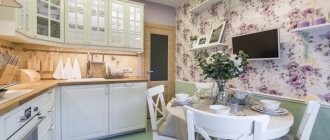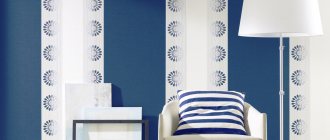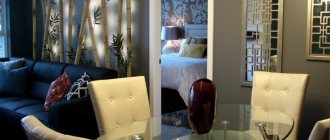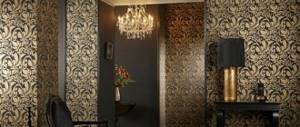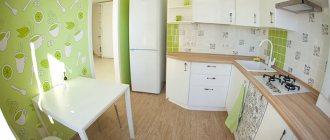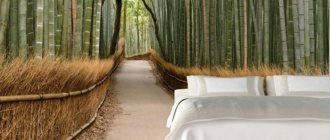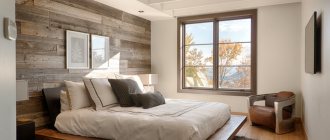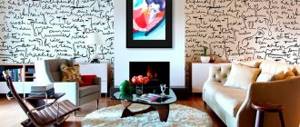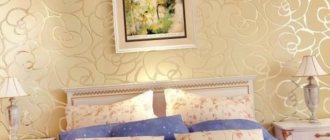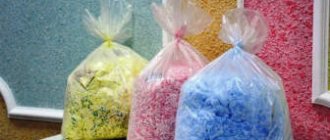Bathroom wallpaper photo
To decorate a bathroom, plastic panels and tiles are traditionally used. Wallpaper for the bathroom is often not even considered, since most people believe that paper will not withstand exposure to steam and water. But is this really true? This issue needs to be studied from all sides.
Should you use wallpaper in the bathroom?
Opponents of decorating a bathroom with wallpaper argue their position by saying that wallpaper is water-permeable and hygroscopic, that is, it gets wet under the influence of water and absorbs moisture from the air. Therefore, it is believed that wallpaper for the bathroom is unreliable and impractical: subsequently it can simply fall off the wall. But this only applies to ordinary paper wallpaper.
However, there are now wallpapers that are specifically designed for such conditions. Wallpaper for the bathroom has its advantages, and with the right choice of materials, troubles are completely eliminated.
- by choosing this coating you can significantly reduce the cost of bathroom renovations, because wallpaper is much cheaper than tiles or panels;
- no other material provides such a variety of textures, patterns and colors, which allows you to realize almost any design solution;
- decorating a bathroom with wallpaper is much easier than with plastic panels or tiles; you can do it yourself without involving specialists; if necessary, removing wallpaper is also easy;
- If some of the wallpaper has fallen off, then it is quite easy to glue it on without replacing the coating as a whole.
Of course, decorating a bathroom with wallpaper will appeal to lovers of variety. Since they, in comparison with the same tiles, which are laid for several years (or even decades), can be changed as often as you want. And each time the bathroom design will be completely different.
Wallpaper for the bathroom: features of choice and varieties
When choosing wallpaper for the bathroom, you should immediately abandon simple paper wallpaper. They are not suitable for rooms with high humidity and temperature changes.
Moisture resistance is the main condition of choice. Wallpaper must be made either from moisture-repellent materials or impregnated with specially designed compounds. As a rule, the label of such wallpaper says o.
It is also necessary to choose the glue carefully. It must be waterproof, withstand temperature changes and constant dampness, have increased adhesion, and contain anti-fungal mixtures.
Washable
Washable wallpaper has a special coating that protects it from moisture getting inside and protects it from delamination or getting wet. Such wallpaper can be easily cleaned of dirt and dust using a wet sponge or cloth. Therefore, keeping it clean will be quite easy.
Vinyl
Vinyl wallpaper is the most widely accepted material for the bathroom. Since they are produced on a polymer basis, they are not afraid of not only steam and high humidity, but also direct contact with water. Their high price does not give the right to talk about the cost-effectiveness of repairs, but they last a very long time and do not lose their qualities.
Due to the fact that these wallpapers are heavy, they require a special adhesive that provides an increased level of adhesion.
Liquid
Liquid wallpaper differs significantly from ordinary wallpaper. In essence, it is a water-based plaster consisting of silk and cotton fibers, astringents, mineral additives and sometimes glitter. This material is sold in dry form. During work, it is diluted with water and applied to a previously prepared wall in the same way as ordinary plaster. Liquid wallpaper coating is distinguished by its original texture and unique pattern. You can make liquid wallpaper waterproof by covering it with acrylic varnish.
Glass wallpaper
Fiberglass wallpaper is made from fiberglass and impregnated with a special composition based on modified starch. Glass wallpaper is an expensive, but very reliable, moisture-proof, long-lasting, environmentally friendly, non-flammable coating. It is distinguished by a variety of textures; during use, glass wallpaper can withstand repainting with water-based or latex paints up to 20 times. Since glass wallpaper does not have the ability to accumulate static electricity, it does not collect dust, and it is not difficult to keep the walls clean.
To glue glass wallpaper, you need to use a special glue for heavy wallpaper; it should only be applied to the wall. You can paint such wallpaper only after the glue has completely dried, about a day after gluing.
Photo wallpaper
One of the walls can be decorated with photo wallpaper, which will change the interior of the bathroom. This is done quite quickly and is inexpensive. The design and color of photo wallpaper is limited only by the imagination of the apartment owner. It is important that photo wallpaper for the bathroom is waterproof.
Types and varieties of wallpaper
When buying washable wallpaper for the bathroom (such as those shown in the photo), it is important to understand that paper-based rolls are not suitable for the intended purposes. It is necessary to give preference to moisture-resistant canvases, those whose front layer is impregnated with special water-repellent compounds.
Manufacturers use special markings to designate such products and put “three waves” on the rolls.
- Washable wallpaper, its front layer is protected by a special moisture-proof film, it reliably protects the base from moisture and perfectly withstands direct contact with water. Experts, when asked how to wash washable wallpaper, draw attention to the possibility of cleaning using a damp sponge. In order for the chosen type of finish to last for a long time, it is important to approach the choice of adhesive in the bathroom; glue and paint the wallpaper using moisture-resistant adhesive compositions with additives that have increased adhesion.
- Vinyl wallpaper is the best choice. Their base is made of a polymer, so the canvases perfectly withstand not only moisture, but also hot steam. You can find paintable vinyl wallpaper on sale. They are quite expensive, but their service life is much longer than simple washable options. Over time, vinyl wallpaper for painting does not lose its decorative effect, the photo once again confirms this. It’s not difficult to create an exclusive interior using them.
- When creating interiors, you can choose liquid wallpaper. They are not at all like paintable rolls. It is better to compare such material with decorative plaster. In essence, this is an ordinary water-based plaster. But this should not be alarming. If you paint the repaired surface with acrylic varnish, you can make it waterproof and the liquid wallpaper itself washable.
- Glass wallpaper is a painting option. When creating them, special fiberglass is used, which is additionally impregnated with other special compounds. It is they who make the canvas waterproof and non-flammable. Today, glass wallpaper is the most expensive finishing material, but with its help you can create truly luxurious interiors, such as shown in the photo. Such rolled material can be painted with latex paints; painting can be done up to 20 times. At the same time, the material does not accumulate static electricity, which means dust will not be attracted to the surfaces of the walls. For gluing glass panels, glue suitable for heavy wallpaper is used. The walls are coated with it; the front layer can be painted only after the fiberglass has completely dried.
- Adhesive films (here they are in the photo) are another type of washable wallpaper. They are not intended for painting; this type of rolled material requires the presence of a special adhesive composition on the reverse side. A waterproof PVC film is applied from the face to the canvas. This finishing option is best suited for cosmetic repairs; gluing the film to the wall is as easy as shelling pears.
- Photo wallpaper is an option that allows you to decorate your bathroom as beautifully as possible. For similar purposes, you can use those made from vinyl. They will be able to withstand difficult operating conditions, while allowing for incredible beauty.
- The features of pasting such rolls are revealed in the video posted at the end of the article. Before pasting, it is recommended to watch a video on how to remove such canvases from the wall.
Pasting wallpaper for painting and ordinary washable canvases is no different from gluing roll materials in other rooms. But here special attention must be paid to creating perfectly even joints. If a material is selected for painting (it is clearly visible in the photo), the paint will be able to seal them and create an airtight surface. Regular washable wallpaper is glued end-to-end; the edges of the sheets must be coated more thoroughly before gluing.
How to glue wallpaper in the bathroom?
The process of wallpapering a bathroom is the same as in other rooms. The walls are pre-prepared: leveled, treated with anti-fungal solutions, and primed.
Then, according to the instruction on the box, you need to prepare glue that is suitable for this type of wallpaper.
Wallpaper should be marked and cut into strips of the required height. If you choose wallpaper with a pattern, you need to combine it.
Glue must be applied to the wall and, if necessary, to the canvas with a brush or roller. Particular attention should be paid to the edges of the canvas. Then apply the strip to the wall, aligning the edge of the canvas with a pre-drawn perpendicular line, and smooth it with a roller from the middle of the canvas to the edges, removing air and smoothing the strip. Subsequent strips are glued end to end.
Washable and moisture-resistant wallpaper for the bathroom
Which wallpaper is best and which can be hung in the bathroom? Manufacturers produce many varieties suitable for such premises and rooms, which have the full range of necessary properties and are practical in a wide variety of conditions. Let's highlight the most basic types, their degree of water resistance and definition by labeling.
- Vinyl wallpaper for the bathroom. One of the most durable roll options for framing walls. For the bathroom, toilet, bathroom, kitchen and loggia, choose non-woven models. They are characterized by increased performance properties, cope well in humid environments, are endowed with super washable qualities and distinctive aesthetic capabilities. They are offered in different colors, various reliefs, three-dimensional images with play of shadows, imitate other coatings or have their own individual design. They convey the relief best of all, thanks to the ability to foam the vinyl, acquiring convex shapes and the process of dense embossing, where the vinyl is obtained in a more rigid form with a clear relief image, to imitate other textures. They do not fade, do not absorb odors, are plastic and pleasant to the touch, repel water and dirt, but have a low degree of air permeability and can form condensation. After installation, the joints are invisible and, due to their density, do not highlight possible wall roughness. The most common type of wall decoration in the bathroom is wallpaper.
- Non-woven wallpaper for the bathroom and toilet, can it be glued? This is a practical canvas with the necessary set of characteristics. They have earned wide popularity and positive reviews for their use in bathrooms. Among their varieties, products based on non-woven fabric are suitable; non-woven fabric is cellulose fibers, and through production processing they acquire the necessary strength and elasticity. Such canvases are distinguished by a wide variety of background illustrations, including those imitating other materials. They are waterproof, withstand UV light well, and do not accumulate odors. They have a dense two-layer structure, due to which they hide minor surface roughness well and undergo chemical treatment with synthetic compounds, gaining immunity to mold. They form a monolithic base without visible seams and can be repainted multiple times. Unlike vinyl models, they have better throughput, which guarantees the absence of condensation and are better protected from the formation of mold and mildew.
- Cork wallpaper on non-woven fabric. The structure is made in two layers, where the foundation is non-woven, and the top layer consists of natural cork. The outer part is a wood material made of cork, which is applied in granules of different sizes or in solid pieces, then treated with protective compounds and wax, forming a decorative veneer. Externally they convey a wood texture, simulating the shapes of stone, brick and other design options, or the natural look of oak. The color scheme is made in warm shades, usually from light beige to dark brown, also with the addition of other tones of blue, red, white, combining two or three colors at the same time. To increase sound insulation, models with agglomerate are produced; it is a separate layer between the base and the veneer layer, and consists of crushed glued cork. Thanks to wax treatment, veneer repels water and dirt well, does not absorb odors, does not change color from ultraviolet radiation, maintaining its original appearance for many years. They are natural and natural building materials. Cork sheets are considered a premium variety and are more expensive.
- Bamboo wallpaper. Is it possible to glue them in the bathroom? According to its technical data, this material is universal and suitable for any space. Main advantages; water resistance and lack of warping, unlike wood, they do not change shape from high temperatures and changes in humidity levels, do not rot, and this is their natural feature, since bamboo grows in water. Natural, washable and breathable fabrics, due to their density, hide surface imperfections. Structure; textile mesh on which bamboo strips are applied. Dimensions; Available in different widths up to 1 meter or more, and different thicknesses of bamboo dies. Appearance; There are impregnated with decorative and protective solutions, laminated, and simple untreated models, with the ability to add color yourself. The color is offered from light to dark options, with a natural appearance of its own texture. They are easy to finish, can be easily cut with a knife, scissors or a hacksaw, and can be joined to any surface using glue for heavy materials. In the bathroom they can be used in any area.
- Glass wallpaper in the bathroom and bathroom is one of the most practical options. They are endowed with high-strength properties, confirming their popularity with positive reviews and comments from specialists who used them in repairs. They are made of fiberglass which is not susceptible to moisture. Particularly strong and durable, withstanding an operational period of up to 30 years. This is a modern glass fiber coating made from natural ingredients; quartz sand and other fillers. The texture is created from glass threads by yarn, and from the difference in the thickness of the thread and the method of yarn, different reliefs are formed, but not voluminous, after which they undergo a special treatment of blotting in starch, acquiring a stable shape. Wear-resistant, durable, allow steam and air to pass through, are not afraid of physical and chemical influences, do not collect condensation, withstand temperature changes, and do not support combustion. They are usually produced in white color, and the tone is imparted by applying interior paint. They are dense and hide minor defects in the walls, performing the function of reinforcement. There are single-layer and multi-layer, and they are also differentiated by grade. Divided into types; some of them require finishing putty, which reinforce and level the walls; the second ones are intended for finishing coating, but require the application of paint; and finished finished models with decorative design.
- Self-adhesive wallpaper, film, and roll coverings with an adhesive backing. For bathrooms, they produce canvases that have an adhesive structure; for the base, a waterproof film on polymers made of PVC materials, cork roll coverings, vinyl and satin wallpaper are used. Single-layer PVC films require a perfectly smooth base for application; they cover not only walls, but also objects, furniture, doors and window sills. Multilayer types, with a decorative outer layer, are satin, a subtype of vinyl, differ in variations of photo effects, silk-screen printing and the ability to imitate. Vinyl trellises, with glue applied to their base and for their installation the base must be wetted with water, they are offered in a more meager range of textures, in contrast to simple vinyl wallpaper. Chalk wallpaper, like an analogue of slate paint, comes in a black version; you can draw on it with chalk, which can then be easily removed with a damp sponge. Self-adhesive cork in rolls is also suitable for the bathroom; it consists entirely of wood on which an adhesive structure is applied. Such trellises are convenient due to the fact that they are glued without glue, directly to the prepared wall. The cost of such coatings is higher compared to standard models. PVC film and cork rolls are not wallpaper, forming separate types of rolls.
- Photo wallpaper can be non-woven, vinyl, or paper types. Their distinctive feature is the pattern, and the base is standard materials. For the bathroom, choose non-woven models with polymer additives that hold up well in bathroom conditions. Also, some models of satin self-adhesive are classified as roll wallpaper with photographic patterns.
Also read: Decorative plaster; what is it and what are its benefits
- The coatings listed above are waterproof and washable, with the ability to wash with damp cloths and even brushes. These are the most suitable canvases of all types of wallpaper. In terms of their scope of application, they are suitable for rooms with an aggressive environment and a high humidity threshold; they are glued even in areas of direct contact with water, in the area of sinks and showers. They have the best strength, but with a high price.
- In the design of walls, you can also use jute, metallized canvases, which are used for the interiors of bathrooms with a large area, mainly used to partially cover the surface, as decorative inserts, in places of least use and away from the water source.
- Wallpapers on paper canvas, with an acrylic, non-woven, vinyl, or latex top layer are also washable, but they have less resistance to a humid environment and a shorter service life. When applying them, it is better to avoid areas of direct contact with water.
- Liquid wallpaper deserves special attention. Cotton and silk mixtures are chosen for bathroom walls. They can decorate the interior in an original way, but this is not the best option. They swell from water and should not be applied near sinks and showers. To increase water resistance, they are additionally coated with varnish. More details about them can be found at this link.
- The use of wallpaper in such rooms often involves combination with other building materials. This technique is used for practical purposes and to expand the decorative effect, where wallpaper plays a decorative role and is glued in low-traffic areas.
- When choosing wallpaper, you need to familiarize yourself with the coating markings, where certain signs determine their level of water resistance and methods of care, dividing them into several types. Moisture-resistant, washable, with increased durability, wear-resistant and brushable, especially resistant to cleaning. The manufacturer may differentiate by category in different ways, with explanations and recommendations for use, check with consultants. It is based on these labeling indicators that the final choice is made.
Also read: Types of drywall and its characteristics
- For the wettest areas in the bathroom, you should choose models with three or more stripes and a brush mark. A sign with 3 stripes indicates that they are not afraid of water and household chemicals, a mark with a brush indicates that they can be cleaned with additional tools. Products with one and two stripes can be used far from a water source.
Wallpaper for bathrooms photo
Thus, the use of wallpaper in bathroom design is completely justified. The main thing is to approach the selection process wisely, because the use of this material will allow you to create an original, comfortable and unique bathroom.
